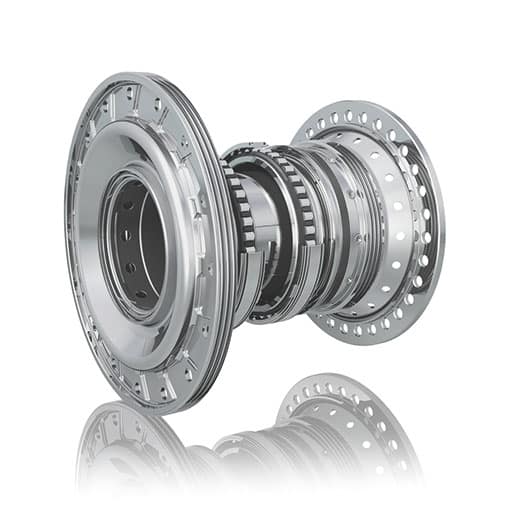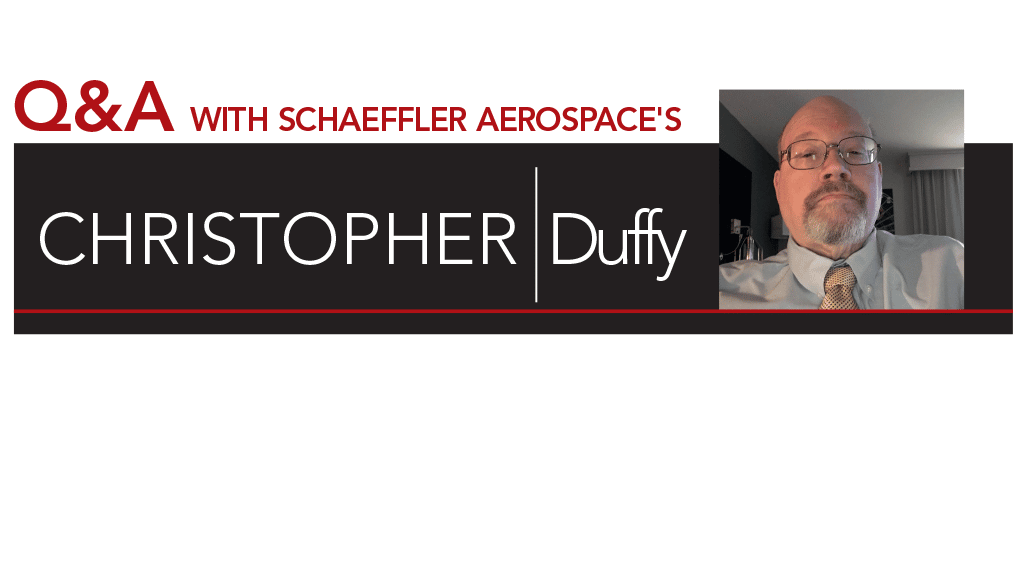AVM: Give our readers a bit of background about Schaeffler’s history and involvement in aerospace.
Duffy: Schaeffler Aerospace’s team lineage goes back to bearings used in the Spirit of St. Louis’ first trans-Atlantic crossing. Its predecessor companies’ manufacturing facilities are the famed Schweinfurt, Germany, bearing factory and the Danbury, Conn., factory which made the secret Norden Bombsight work. Today, whether it flies under water, in the air or in space, Schaeffler Aerospace has a dominant presence.

AVM: Focus in on the MRO work that Schaeffler does. What capabilities does your company have and when should maintenance professionals look to Schaeffler for help?
Duffy: Our primary focus is overhaul of main shaft power plant bearings which have the highest value in a jet engine. In addition, we work on high-value components associated with bearings such as planetary pinions or bevel pinions in helicopter transmissions. These associated components typically fit well within our capability of manufacturing rotating parts. Along with main shaft bearings, we routinely work on gearbox bearings such as upper tower shaft positions. If it is a bearing that flies, no matter what the value, we can at least do a relubrication or inspection with recertification. On lower-value items, while many are not able to compete with new part pricing, we can compete with lead times. Raw material lead times for aerospace precision bearings are currently 62 weeks with an additional 26-week manufacturing lead time. An inspection and recertification are typically less than seven calendar days, while an overhaul is typically less than three weeks.
AVM: Schaeffler is well-known for bearing work — talk about what makes your services in this area unique and standout.
Duffy: I think there are several reasons. First, our global footprint allows us to service our customers in the region for the region. Secondly, Schaeffler and its predecessor aerospace companies are known for engineering solutions where the OEM has a problem. We aggressively seek to develop material processes and combine those with our other technologies to bring those solutions to market. One example would be the combination of plasma nitriding with silicon nitride rolling elements. Another would be Schaeffler’s proprietary Cronidur 30 material. Our global aerospace network can bring our technology to market and upgrade existing componentry where the customer needs it. We are not a low-cost provider nor merely a commodity supplier. Finally, we think all customers are important. We do not have A, B or C customers. We try to work with everyone where a solid business case exists.
AVM: Give our readers some specifics on how you analyze and diagnose components when they come to you.
Duffy: We do it from two sides. On the OE side of the business, in support of our customers testing for new product, our engineering teams do a comprehensive evaluation and propose changes to enhance durability and life. On the MRO side, some of what we do is statutory. Inspection for hidden damage, handling damage and shipping damage are part of the regulatory requirement. Going beyond that, of course we apply the approved or accepted technical data, but with our vast bearing experience, we can apply our latent knowledge to further enhance serviceably. And finally, we apply our tests developed over the years, such as noise testing or torque testing, to further ensure bearing serviceability.
AVM: Schaeffler does work for both the civilian market and military communities. Where possible, give some examples of work that the company does in both markets.
Duffy: It is really the same business; however, it may be limited to a given region. For commercial work, our global repair station network can handle all that work. We will “storefront” where a particular location does not have a qualification or inventory and internally send work to our network where that qualification/inventory exists, while still meeting turn times. An example would be the CFM56 series engines or the Geared Turbo Fan (GTF) series of engines. We still must follow export controls. In some cases, on the commercial side, we can support a replacement or surplus option where we procure our bearings, overhaul them, and make them available to the market. On the military side, export controls and international trafficking of arms regulations limit us to keeping that business within one of our organizational regions. For example, with the F119 engine which goes on the F-22 Raptor, these bearings and components are only manufactured and serviced in North America. In some of these instances, we may have a performance-based logistics solution in place where we guarantee a monthly volume of repairs with a surge capacity.
AVM: Supply chain woes continue to haunt aerospace. How is Schaeffler able to help operators and MROs during this time of supply chain challenges?
Duffy: Schaeffler does face similar challenges with the supply chain; however, Schaeffler decided early on in the pandemic to maintain a high raw material inventory and keep staffing levels at pre-pandemic levels to help insulate our business form some of the possible and now occurring disruptions in the supply chain. Of course, as time marches on, that inventory has been drawn down, and with a 62-week raw material lead time, we are having to look out ahead several years for purchases. In addition, while not always price competitive, the MRO option helps our customer base keep going.
AVM: Talk about market demand — what are you seeing in this area and how is Schaeffler responding?
Duffy: Up, up and away. In our Americas region, the pandemic had little impact on our MRO business and our OE business remained strong. 2022 was an extremely strong year in the Americas with our repair stations performing substantially above budgeted sales and at times straining our turnaround. In fact, growth in the Americas did not seem to be impacted by the pandemic. Globally, 2022 started to see the wide-body market return to some level of normalcy and our European market closed close to pre-pandemic levels. Our challenge now is getting the raw material, human capital, and equipment to service this extremely strong demand, while maintaining efficiency.
AVM: Does Schaeffler have new programs that our readers should be aware of?
Duffy: We are always working on future projects with OEM’s but regrettably, because of two-way nondisclosure agreements, I can’t name names or mention specifics other than to say the projects cover fixed wing and rotary wing applications, including EV technologies. These are both of a commercial and military nature. On relatively new programs like the Pratt & Whitney GTF series, we have very strong participation with both IAE LLC and Pratt & Whitney as the primary OE of the main shaft bearings and 100% of the bearing MRO business on all makes and models of the GTF program. This participation has allowed us to start reaching beyond bearings and actively bid on non-bearing components. We are diligently working with GE on their portion of the LEAP-X program and we were the first MRO supplier for the GENx engine that is dominant on the B787.
AVM: Talk about how your company can work in very diverse areas including wide-body and narrow-body, civilian and military, fixed wing and rotor areas. How does Schaeffler manage that?
Duffy: Our global footprint allows us to have some specialization in the regions. An example of this would be in the Americas region with two manufacturing locations, each with a licensed MRO facility within them. One location focuses on larger or high-thrust commercial and military engine bearings. The other facility focuses on smaller power plant components, auxiliaries, gearboxes, and miniature/instrument product. On the MRO side, one facility focuses on large main shaft bearings with licensed OEM repairs. Meanwhile, the other facility focuses on lower-value bearings like in a helicopter transmission, smaller power plants with a lower level of repair, and non-OEM repairs. This facility also processes high volumes (over 1000 per month compared to 200) of parts per month.
AVM: What changes are you all seeing in the regulatory environment? Are things improving or getting more difficult? What can the regulators do to improve the regulatory environment?
Duffy: Improving as we move towards more bilateral agreements. It has improved both understanding and costing. For us, the CAAS in Singapore now covers for the FAA in the U. S. Instead of paying for an inspector to do oversight from the FAA IFO in Los Angeles, the local authority does that oversight. While relations may currently be tense with China, as the Chinese regulatory environment matures, developing more bilateral agreements will further smooth the process. The CAAC has an agreement in place with the CAAS in Singapore, so like the FAA, the CAAC will be covered by the local civil authority. With the exit of Great Britain from the EU, bilateral agreements will be developed to cover business across the globe and help minimize the impact of the change.
AVM: Schaeffler invests in research and development in many areas. Talk about the company’s commitment to R&D. Share some ideas that have been brought to life from your R&D efforts.
Duffy: Schaeffler is a firm believer in R&D across all the markets it participates in and some of those technologies can work in several markets at the same time. In the past, examples as I have given include Cronidur 30 material, M50NiL material, plasma nitriding and using silicone nitride rolling elements in conjunction with nitride surfaces.
AVM: Electric vehicles are becoming a reality, even in aviation. Is Schaeffler getting involved in this area? What insights can you share about that?
Duffy: As you may have read, Schaeffler has a strong commitment to the EV market given that sustainability is one of the company’s core values. Often, this technology is developed for the automotive portion of the business, and then scaled up to meet the demands of aerospace. An example would be an EV booster system used on a police interceptor. While not on the market yet, you certainly could take that technology and use it on a powerplant for an aircraft for boosting during critical portions of flight such as takeoff or landing. About drones, we already are supplying OEMs that make small EVs for aerospace. Schaeffler’s commitment is further exemplified by acquisitions that would support the EV marketplace.
Christopher Duffy is the director of strategy and business development at Schaeffler Aerospace where he is responsible for the growth and support of the aerospace bearing repair and overhaul business with locations around the world. He has matrix management responsibility for the global repair station network including expansion and addition of new locations. In addition, he is responsible for establishing and maintaining the aerospace MRO and new parts strategy.
